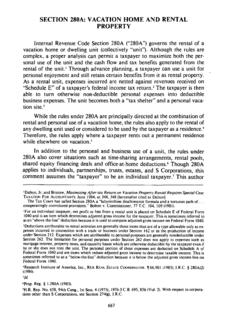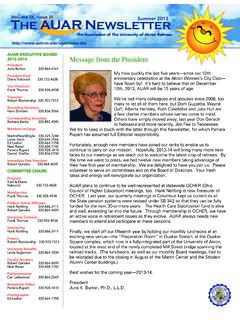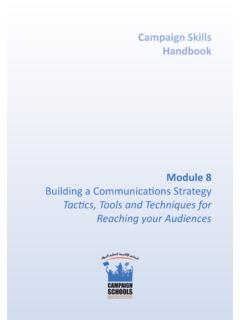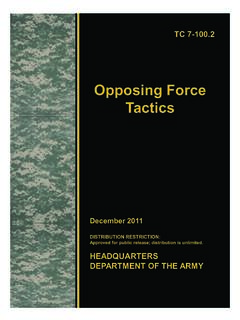Transcription of INTRODUCTION TO TACTICS II - University of Akron
1 Section3 Key Points1 The Three Individual Movement Techniques2 The Two Fire Team Movement FormationsINTRODUCTION TOTACTICS IIInfantry platoon and squad leaders must be cannot rely on a book to solve tactical must understand and use initiative inaccomplishing the mission.. The art of making sounddecisions quickly lies in the knowledge of TACTICS , theestimate process, and platoon and squad techniquesand andTechniques Track8420010_TT3_p168-177 8/26/08 11:32 AM Page 168 TACTICS andTechniques TrackIntroductionFrom the INTRODUCTION of the muzzle-loaded smoothbore musket until the mid-19thcentury, infantry units in Europe and the Americas maneuveredin long lines andlarge formations.
2 The idea was to subject the enemy, who stood or knelt in similarformations, to massed fire at short range. Often these formations got off one shot,then charged the enemy with fixed changed during the American Civil War with the advent of the rifled musket,conical bullet, repeating rifle, and primitive machine gun. Infantry TACTICS did not keeppace with these advances in weaponry, and this led to the increased carnage at battleslike Fredericksburg, Gettysburg, and Cold Harbor. The bloodbaths on World War I battlefields, where British, French, and Germaninfantry charged futilely into machine-gun and grenade fire with massive losses,showed the gap between increasingly lethal military technology and outdated infantrytactics.
3 Fortunately for the Soldiers of today, much has changed. The modern, trainedArmy uses traveling techniques, movement formations, and coverand concealmentto advance on or defend objectives with the fewest possible casualties. In this section,you will learn how to move under fire, as an individual and as part of a fire team. In his book, Steel My Soldiers Hearts, COL David Hackworth relates how hisbattalion surgeon, CPT Byron Holley, welcomed a young medic to Vietnam: Learning to CrawlHolley couldn t help remembering his own baptism by fire and told Billy howwhen he heard the bullet snapping by barely a foot above his head, it was thefirst realization I had that, hey, a guy can get killed pretty easy over here.
4 I lookedup at the moon and prayed, God, please don t let me die in this hellhole. And itwas just like I heard a voice saying: Relax, everything s going to be just fine, justremember what you learned in basic training when the lead s flying, get yourbutt down. It was like a protective shield came around me and I lost any fear. AndI learned fast that you can cover a lot of territory crawling. David H. Hackworth The Three Individual Movement TechniquesAs Holley learned, knowing how to move on the battlefield is the key to staying alive. Butbefore you move, you must know where you want to move to next. Stay on the route thatyour leader selects for the team.
5 Then identify the next covered or concealed position thatis nearby. Select your route to your next position so you are exposed to the least amountof enemy fire. And don t forget you don t want to cross in front of your other squadmembers fires, protect yourself, it s important to consider the difference between coverandconcealment. Cover will afford you a degree of protection from enemy direct or indirectfire. Depending on the type of cover, cover can also provide concealment from enemyobservation. Concealment means the enemy can t see you, but concealment doesn t protectyou from enemy direct or indirect of forces inthe battlespace throughmovement incombination with firesto achieve a position ofadvantage in respect tothe enemy in order toaccomplish the missioncoverprotection from theeffects of direct andindirect firesconcealmentprotection fromobservation andsurveillanceIntroduction to TACTICS II 1698420010_TT3_p168-177 8/19/08 10:56 AM Page 169 There are varying degrees of cover and concealment.
6 Tall grass or dense vegetation willhelp conceal your movement, but will not stop a bullet or shrapnel from direct or indirectfire. Getting behind a tree or a wall will help stop bullets, and may improve yourconcealment, but will not afford much protection from indirect fire. Occupying a positioninside a building will improve your cover from direct and indirect fire and may offer betterconcealment from enemy now you have identified your next covered position, and you know which routeprovides the best cover or concealment. You have three options for movement: the highcrawl, the low crawl, and the 3 5 second rush. You choose which one to use depending onthe conditions you face such as the terrain and the likelihood of enemy contact or, ifyou are already receiving enemy fire, on the enemy fire s degree of accuracy.
7 Features suchas a gully, ditch, ravine, or wall can provide cover and concealment when you use the lowor high crawl. Features such as hedgerows or lines of thick vegetation offer concealmentonly when you use the low or high crawl. (Remember that high grass or weeds only partiallyconceal you, since the movement of the grass as you crawl could give away your position.)Large trees, rocks, stumps, folds or creases in the ground, or vehicle hulks can give youcover and concealment in a temporary the enemy fire you are receiving is from a great distance or is inaccurate fire, it maybe best for you to move quickly out of the enemy s line of fire by conducting 3-5 second170 SECTION 3 Figure Types of Movement8420010_TT3_p168-177 8/19/08 10:56 AM Page 170 INTRODUCTION to TACTICS II 171 Figure High CrawlFigure Low Crawlrushes.
8 If the enemy s fire is close, and somewhat accurate or effective, you may need tohigh crawl out of the enemy s fires or to a covered position. If you are receiving close,accurate, or effective enemy fire, then in order to survive, you must give the enemy thesmallest possible target by low crawling to the nearest exception to this would be if you were the target of a close ambush. In this case,you would immediately return fire and assault through the ambush in order to get out ofthe kill zone and survive. This technique is known as a battle drill. You will learn moreabout battle drills later in Low Crawl The low crawl offers you the greatest protection with the slowest movement.
9 Use the lowcrawl when you do nothave to move quickly and you have less than a vertical foot ofcover and concealment (or when the enemy has good visibility).With the low crawl, you hug the your body as flat as the upper sling swivel of your weapon and let the weapon trail behind you(see Figure ). The hand guard will rest on your forearm and the butt of theweapon will drag on the ground. Keep the muzzle off the both arms forward and pull your right leg forward. Move forward bypulling with your arms and pushing with your right leg. Continue to push, pull,and move. Switch legs as you get High Crawl Use the high crawl when you have to move quickly and your route offers cover andconcealment (or when poor visibility limits enemy observation).
10 The high crawl is a modified version of crawling on your arms and your torso off the ground and rest your weight on your forearms and lowerlegs or your elbows and your your weapon in your arms and keep the muzzle off the ground (see Figure ). your knees behind your buttocks so your buttocks stay forward on your right elbow and left knee, then follow with your leftelbow and right 8/19/08 10:56 AM Page 171172 SECTION 3 The 3-5 Second Rush The 3-5 second rush as the name implies offers you the fastest movement with the will be exposed. Use the rush when you have no cover or concealment, andbreaks in enemy fire allow you to expose or crawl away from your fighting up with your arms.
















